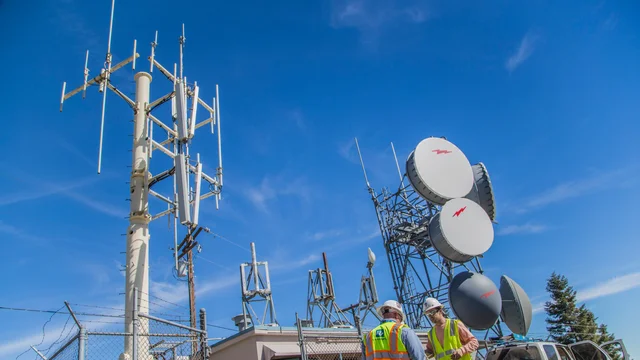
Building the business case for 800 MHz spectrum: A strategic asset for utility grid modernization.

Developing private broadband networks with Private LTE (pLTE) and 5G is essential for a more modern, connected and resilient grid. To capture the full benefits of a private network investment, spectrum ownership is emerging as a critical strategic asset. With the recent availability of 800 MHz, Band 26 spectrum, utilities now have a new, viable option—one that aligns with a large vendor ecosystem and supports scalable, interoperable LTE and 5G networks.
But how do you show executive leadership that spectrum is more than a technical upgrade? How do you build a compelling, financially sound case for acquiring licensed spectrum that illustrates the tremendous cost benefits across the utility organization? This guide walks through the key elements of building a robust business case for utility spectrum acquisition, comparing available options, and aligning your spectrum strategy with long-term operational goals.
Why Now? The strategic timing of 800 MHz Band 26
The availability of 800 MHz spectrum marks a pivotal moment for utilities – offering
Alignment with a large commercial device ecosystem, reducing integration and life cycle costs
Wide-area coverage ideal for both urban and rural deployments
14MHz of broadband bandwidth, the most of any utility spectrum to support current and emerging requirements
Scalable capacity to maximize the cost benefits for mission-critical applications holistically across the utility organization such as wildfire prevention, AMI 2.0, Volt/VAR, distribution automation (such as FLISR, PMUs, Volt/VAR), integrated Mission Critical Push to Talk (MCPTT), management systems and cybersecurity
This makes it a future-ready investment for utilities seeking to modernize their communications infrastructure and eliminate the risk of reliance on public networks or narrowband options.
Comparing spectrum options: A practical framework
When evaluating spectrum, utilities must weigh the pros and cons of licensed vs. shared spectrum. Here’s a framework to guide your decision:
This comparison helps justify why licensed spectrum for utilities, especially Band 26—is a more secure and scalable choice for long-term grid modernization. For more insight into how 800 MHz Band 26 compares to other licensed spectrum options like 900 MHz, explore this spectrum comparison FAQ.
Key business case drivers
To gain C-suite support, align the spectrum acquisition to strategic business outcomes. Here are the top drivers:
Safety: High speed deterministic network to support man down applications and prevent wildfires and resultant loss of life and property.
Operational Efficiency: Reduce truck rolls, improve outage response, and enable real-time grid visibility to improve grid resiliency. · Mutual Aid Readiness: Ensure interoperable communications during emergencies and disaster recovery- ensuring faster storm response and recovery.
Private LTE/5G Cybersecurity: Own and control your network to reduce exposure to security vulnerabilities.
Workforce Enablement: Support mobile field crews with secure, high-speed connectivity - enhancing safety and effectiveness.
Grid Modernization: Enable advanced applications like DER integration, AMI 2.0, distribution automation and predictive maintenance.
These drivers position 800 MHz spectrum as a strategic enabler of utility transformation—not just a technical asset.
Financial modeling tips: quantifying ROI
A strong business case includes a clear total cost of ownership (TCO) and return on investment (ROI) model to focus not just on upfront costs, but evaluates the broader financial impact by quantifying the specific cost benefits that can be realized by implementing a pLTE and 5G network. Here’s what to include:
Spectrum acquisition costs
Network infrastructure (towers, core, radios, edge devices, backhaul)
Device and endpoint integration
Ongoing operations and maintenance
Cost avoidance (e.g., no long-term lease, reduced network refresh life cycles, elimination of single purpose networks and network consolidation)
Cost Benefits (Grid Resiliency & Reliability, Energy Efficiency, Cybersecurity, Network as a Service, Internet of Things (IoT, etc.)
Align your financial model with regulatory or board-level expectations and highlight how spectrum investment supports long-term cost savings and operational resilience.
Technical design insights: from concept to confidence
Use conceptual Field Area Network (FAN) designs and use case traffic modeling to validate your assumptions. Demonstrate:
· Coverage and capacity modeling across service territories. Capacity will be the primary and governing factor to accurately size the network
· Latency and reliability for mission-critical applications
· Scalability to support future use cases like AMI 2.0, Volt/VAR, FLISR, PMU based EMS and Power Network Analysis and other numerous distribution automation applications
These technical inputs help translate abstract benefits into tangible performance metrics that resonate with both technical and executive audiences.
Real-world validation: learning from industry peers
Utilities across the country are already exploring or implementing private LTE for utilities using 800 MHz. Their experiences offer valuable insights into:
· Business drivers and decision-making processes
· Implementation timelines and challenges
· Operational improvements and ROI achieved
· Quantifying the Cybersecurity cost benefits using Cyber Risk Quantification model (CRQ)
· Lessons learned and best practices
These case studies help de-risk your own journey and provide a roadmap for success.
Final thoughts: A future-ready investment
Whether you're just beginning to explore spectrum ownership or refining your network strategy, now is the time to act.
The convergence of available spectrum, maturing device ecosystems, and increasing grid demands makes this a rare opportunity to invest in a resilient, secure, and scalable communications infrastructure.
By aligning spectrum acquisition with strategic goals, grounding your case in technical and financial rigor, and learning from industry peers, you can confidently present 800 MHz Band 26 spectrum as a future-ready investment—one that positions your utility for leadership in the digital grid era.
Contact Us
Looking for a partner in innovation?
Let's Talk


